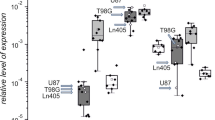Abstract
Purpose. The objective of this research was to investigate the substrate specificity of large neutral amino acid carrier (LNAA) and di/tripeptide (hPEPTl) transporters with respect to PD 158473, an NMDA antagonist.
Methods. Cellular uptake studies were carried out using two types of Chinese Hamster Ovary (CHO). CHO-K1 cells represent the wild type with inherent large neutral amino acid (LNAA) activity. CHO-PEPT1 cells were generated by stable transfection of hPEPTl gene into CHO cells. Therefore, these cells possess both LNAA activity and di/tripeptide transporter activities as a result of the transfection. Cellular uptake of PD 158473 was quantified using a HPLC method previously developed in our laboratory.
Results. The utility of the CHO-PEPT1 cell model was demonstrated by determining the uptake kinetics of Gly-Sar, a prototypical dipeptide transporter substrate. Uptake kinetics of PD 158473 displayed two carrier-mediated transport components in CHO-PEPT1 cells, while in CHO-K1 cells the relationship was consistent with classic one component Michaelis-Menten kinetics. These results confirmed the affinity of PD 158473 for both LNAA and di/tripeptide transporters. Further, results from inhibition experiments using these two cell types indicate that the high affinity-low capacity system was the LNAA carrier and the low affinity-high capacity carrier was the di/tripeptide transporter.
Conclusions. This study demonstrates overlapping substrate specificity between LNAA carrier and di/tripeptide transporter (hPEPTl) for PD 158473, an amino acid analog. Establishing Structure Transport Relationship (STR) for this overlap will aid in a design strategy for increasing oral absorption or targeting specific drugs to selected tissues.
Similar content being viewed by others
REFERENCES
J. W. McDonald and M. V. Johnston. Physiology and pathophysiological roles of excitatory amino acids during central nervous system development. Brain Res. Reviews 15:41-70 (1990).
R. Dingledine, C. J. McBain, and J. O. McNamara. Excitatory amino acid receptors in Epilepsy. Trends Pharmacol. Sci. 11:334-339 (1990).
J. H. Li, C. F. Bigge, R. M. Williamson, S. A. Borosky, M. G. Vartanian, and D. F Ortwine. Potent, orally active, competitive N-Methyl-D-aspartate (NMDA) receptor antagonists are substrates for neutural amino acid uptake system in Chinese Hamster Ovary cells. J. Med. Chem. 38:1955-1965 (1995).
N. Surendran, R. M. Williamson, C. F. Bigge, H. Han, G. L. Amidon, and B. H. Stewart. Can an amino acid derivative utilize the intestinal dipeptide transporter for its transport? Studies with an NMDA antagonist using in-vitro, in-situ and in-vivo models of intestinal absorption. In preparation.
K.-M. Y. Covitz, G. L. Amidon, and W. Sadee. Human dipeptide transporter, hPEPT1, stably transfected into Chinese Hamster Ovary cells. Pharm. Res. 13:1631-1634 (1996).
A. De Lean, P. J. Munson, and D. Rodbard. Simultaneous analysis of families of sigmoidal curves: application to bioassay, radioligand assay, and physiological dose-response curves. Am. J. Physiol. 235:E97-102 (1978).
M. Brandsch, Y. Miyamoto, V. Ganapathy, and F. H. Leibach. Expression of protein kinase C-dependent regulation of peptide/H+ co-transport system in the Caco-2 human colon carcinoma cell line. Biochem. J. 299:253-160 (1994).
P. W. Swaan, Ph.D. Thesis, University of Utrecht, Utrecht (1993).
E. P. Eddy, C. Wood, J. Miller, G. Wilson, and I. J. Hidalgo. A comparison of the affinities of dipeptides and antibiotics for the di-/tripeptide transporter in Caco-2 cells. Int. J. Pharm. 115:79-86 (1995).
I. J. Hidalgo, P. Bhatnagar, C-P Lee, J. Miller, G. Cucullino, and P. L. Smith. Structural requirements for interaction with the oligopeptide transporter in Caco-2 cells. Pharm. Res. 12:317-319 (1995).
P. W. Swaan and J. J. Tukker. Molecular determinants of recognition for the intestinal peptide carrier. J. Pharm. Sci. 86:596-602 (1997).
J. Li and I. J. Hidalgo. Molecular modeling study of structural requirement for the oligopeptide transporter. J. Drug. Targeting 4:9-17 (1996).
C. S. Temple, J. R. Bronk, P. D. Bailey, and C. A. R. Boyd. Substrate-charge dependence of stoichiometry shows membrane potential is the driving force for the proton-peptide cotransport in rat renal cortex. Pflugers. Arch. Eur. J. Physiol. 430:825-829 (1995).
V. Ganapathy, M. Brandsch, and F. H. Leibach. “Intestinal transport of amino acids and peptides” In Physiology of the Gastrointestinal Tract., Third Edition, Edited by L. R. Johnson. Raven Press, New York (1994).
J. D. McGivan and M. Pastor-Anglada. Regulatory and molecular aspects of mammalian amino acid transport. Biochem. J. 299:321-334 (1994).
Author information
Authors and Affiliations
Corresponding author
Rights and permissions
About this article
Cite this article
Surendran, N., Covitz, KM.Y., Han, Hk. et al. Evidence for Overlapping Substrate Specificity Between Large Neutral Amino Acid (LNAA) and Dipeptide (hPEPTl) Transporters for PD 158473, an NMDA Antagonist. Pharm Res 16, 391–395 (1999). https://doi.org/10.1023/A:1018821718340
Issue Date:
DOI: https://doi.org/10.1023/A:1018821718340



